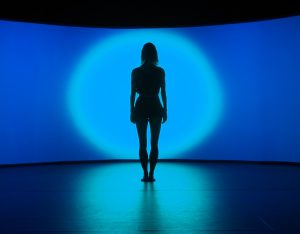Review: Rachel Arianne Ogle, ‘i have loved the stars too fondly to be fearful of the night’ ·
PICA, 5 June ·
Review by Jonathan W. Marshall ·
The techno-digital sublime
6 June 2019
- Reading time • 6 minutesDance
More like this
- How to watch ballet
- STRUT Dance comes of age
- Fairytale leaps to life with fun twist
Rachel Arianne Ogle’s superb precipice concludes with a reveal at the back of the darkened stage, where a curtain draws open to show an intensely glowing, curved wall situated at the rear of a small box, within which stands a sun-struck dancer.
i have loved the stars too fondly to be fearful of the night takes this image and turns it into a short, stand-alone performance installation, with glitchie live electronic music from Luke Smiles and a blindingly purist lighting design and luminescent projections from Benjamin Cisterne.
Smiles, Ogle and Cisterne build here on the optical games and devices that immediately preceded cinema proper, such as the spinning, slotted zoetrope, or the carefully lit and crafted panoramas and moving dioramas of the nineteenth century. Cisterne has previously experimented with patterned moiré effects in lighting with his design for Sydney Dance Company’s 2 One Another (2012). Robin Fox’s use of digital projection and intense, immersive digital noise for Chunky Move is clearly another influence (Smiles previously danced with Chunky Move), as is, presumably, the regular to DarkMofo and the Melbourne Festival, Ryoji Ikeda, with his supra-minimal techno and lighting works for dance and installation. The strongest resonance, though, is with the landmark Morphia series, which dancer Helen Herbertson created with designer Ben Cobham of Bluebottle in the early 2000s, featuring an often agitated, naked Herbertson suspended in a blacker than black space, housed in a glowing white box.

The movement of i have loved the stars too fondly is, however, more minimal than Herbertson’s intimate gestures. Halfway through i have loved the stars too fondly, there is a blink-and-you-miss it section in which Ogle briefly tilts onto an extreme angle and folds herself onto the floor, legs protruding above her, whilst lit by a totalising, white wash. Elsewhere she ever-so-unsteadily walks slowly and with very small steps down the centre line from the back of to the front and then back again. She is, therefore, more object than dancer, more a sculpture than a human.
The sheer over-stimulation of optical and aural signals means that the audience’s perception itself begins to warp (as in a zoetrope or Ikeda’s installations). As the sound pummels us (featuring, for a period, some of the most intense bass thuds I have heard outside of the work of Fox or Decibel), and as the light excoriates Ogle from behind, there are times where it seems she may be perhaps mouthing a silent cry. But the solarisation about her head and shoulders, and the silhouette effect it produces, is such that one cannot be certain.
The framing of the performer within i have loved the stars too fondly, therefore, echoes the work of performance artist Stelarc, who insists on calling himself “the body,” signalling his status an entirely impersonal, fleshy sensate unit sewn into a non-human, technological system. The effect, then, is that the body itself is almost blown apart, shattered and digitised (think the origin of Dr Manhattan in Watchmen). This is the techno-digital sublime in the extreme, producing a mildly terrifying feeling of euphoria and amazement. In the most impressive visual effect within the production, when Ogle stands at the front of the stage, the rapid shifts in the colour and directionality of the light create the illusion of up to six or eight shadowy figures, arrayed in a semi-circle before us, each swimming into existence as its predecessor is blown away by the lighting.
This effect is staged early in the piece, and to some degree the dramaturgy has nowhere else to go. The distorted white dots on the back wall are patterned according to random transmissions picked up while the show is in progress. As Ogle moves away from us in this slightly more forgiving light-and-sound world, one is tempted to read this as a return of the human after its technological auto-da-fé.
But closure is denied and she keeps her back to us. The conclusion seems to arise out of its duration more than it does out of any musical or choreographic evolution per se. While it seemed a shame to end on a whimper rather than a bang, precipice and i have loved the stars represent the sort of work which drew me to dance in the first place: austere, formal, painstaking, and scenographically brilliant – two of the best movement works of 2019.
i have loved the stars too fondly to be fearful of the night runs until June 8.
Read a Q&A with Rachel Arianne Ogle.
Pictured top is Rachel Arianne Ogle in “i have loved the stars too fondly to be fearful of the night”. Photo: Mick Bello.
Like what you're reading? Support Seesaw.






